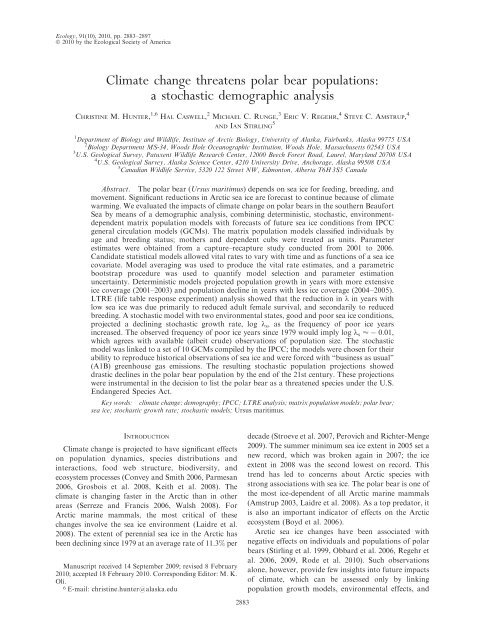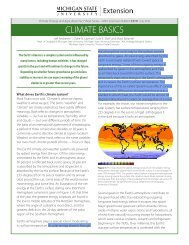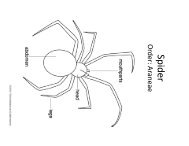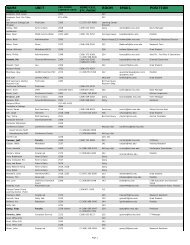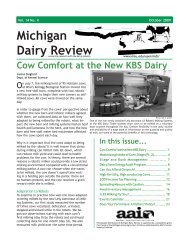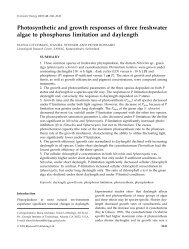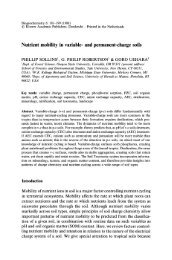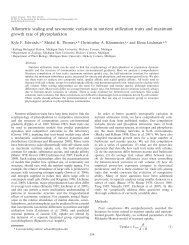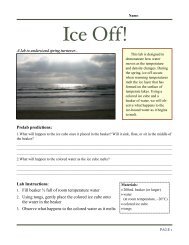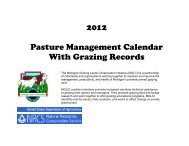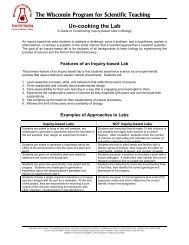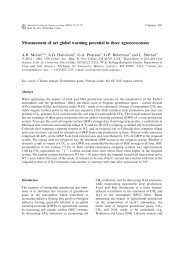Ecology, 91(10), 2010, pp. 2883–2897Ó 2010 by the Ecological Society of America<strong>Climate</strong> change threatens polar bear populations:a stochastic demographic analysisCHRISTINE M. HUNTER, 1,6 HAL CASWELL, 2 MICHAEL C. RUNGE, 3 ERIC V. REGEHR, 4 STEVE C. AMSTRUP, 4AND IAN STIRLING 51 Department of Biology and Wildlife, Institute of Arctic Biology, University of Alaska, Fairbanks, Alaska 99775 USA2 Biology Department MS-34, Woods Hole Oceanographic Institution, Woods Hole, Massachusetts 02543 USA3 U.S. Geological Survey, Patuxent Wildlife Research Center, 12000 Beech Forest Road, Laurel, Maryland 20708 USA4 U.S. Geological Survey, Alaska Science Center, 4210 University Drive, Anchorage, Alaska 99508 USA5 Canadian Wildlife Service, 5320 122 Street NW, Edmonton, Alberta T6H 3S5 CanadaAbstract. The polar bear (Ursus maritimus) depends on sea ice for feeding, breeding, andmovement. Significant reductions in Arctic sea ice are forecast to continue because of climatewarming. We evaluated the impacts of climate change on polar bears in the southern BeaufortSea by means of a demographic analysis, combining deterministic, stochastic, environmentdependentmatrix population models with forecasts of future sea ice conditions from IPCCgeneral circulation models (GCMs). The matrix population models classified individuals byage and breeding status; mothers and dependent cubs were treated as units. Parameterestimates were obtained from a capture–recapture study conducted from 2001 to 2006.Candidate statistical models allowed vital rates to vary with time and as functions of a sea icecovariate. Model averaging was used to produce the vital rate estimates, and a parametricbootstrap procedure was used to quantify model selection and parameter estimationuncertainty. Deterministic models projected population growth in years with more extensiveice coverage (2001–2003) and population decline in years with less ice coverage (2004–2005).LTRE (life table response experiment) analysis showed that the reduction in k in years withlow sea ice was due primarily to reduced adult female survival, and secondarily to reducedbreeding. A stochastic model with two environmental states, good and poor sea ice conditions,projected a declining stochastic growth rate, log k s , as the frequency of poor ice yearsincreased. The observed frequency of poor ice years since 1979 would imply log k s ’ 0.01,which agrees with available (albeit crude) observations of population size. The stochasticmodel was linked to a set of 10 GCMs compiled by the IPCC; the models were chosen for theirability to reproduce historical observations of sea ice and were forced with ‘‘business as usual’’(A1B) greenhouse gas emissions. The resulting stochastic population projections showeddrastic declines in the polar bear population by the end of the 21st century. These projectionswere instrumental in the decision to list the polar bear as a threatened species under the U.S.Endangered Species Act.Key words: climate change; demography; IPCC; LTRE analysis; matrix population models; polar bear;sea ice; stochastic growth rate; stochastic models; Ursus maritimus.INTRODUCTION<strong>Climate</strong> change is projected to have significant effectson population dynamics, species distributions andinteractions, food web structure, biodiversity, andecosystem processes (Convey and Smith 2006, Parmesan2006, Grosbois et al. 2008, Keith et al. 2008). Theclimate is changing faster in the Arctic than in otherareas (Serreze and Francis 2006, Walsh 2008). ForArctic marine mammals, the most critical of thesechanges involve the sea ice environment (Laidre et al.2008). The extent of perennial sea ice in the Arctic hasbeen declining since 1979 at an average rate of 11.3% perManuscript received 14 September 2009; revised 8 February2010; accepted 18 February 2010. Corresponding Editor: M. K.Oli.6E-mail: christine.hunter@alaska.edu2883decade (Stroeve et al. 2007, Perovich and Richter-Menge2009). The summer minimum sea ice extent in 2005 set anew record, which was broken again in 2007; the iceextent in 2008 was the second lowest on record. Thistrend has led to concerns about Arctic species withstrong associations with sea ice. The polar bear is one ofthe most ice-dependent of all Arctic marine mammals(Amstrup 2003, Laidre et al. 2008). As a top predator, itis also an important indicator of effects on the Arcticecosystem (Boyd et al. 2006).Arctic sea ice changes have been associated withnegative effects on individuals and populations of polarbears (Stirling et al. 1999, Obbard et al. 2006, Regehr etal. 2006, 2009, Rode et al. 2010). Such observationsalone, however, provide few insights into future impactsof climate, which can be assessed only by linkingpopulation growth models, environmental effects, and
2884 CHRISTINE M. HUNTER ET AL.Ecology, Vol. 91, No. 10forecasts of the future environment. Although challenging,such assessments are necessary to forecast futuretrends and to inform policy debates and legal decisions.The U.S. Endangered Species Act, for example, requiresan assessment of extinction risks within the ‘‘foreseeablefuture’’ (16 U.S. Congress 1531, 1973).In this paper, we examine the current and projectedfuture effects of climate change on a population of polarbears (Ursus maritimus; see Plate 1). Our approach is todevelop stage-structured demographic models thatincorporate the observed responses of the stage-specificvital rates to sea ice conditions. We then present a novelapproach to connecting these demographic models toforecasts of future sea ice conditions from IPCC globalcirculation models (GCMs). The results reveal effects ofclimate on short-term transient dynamics, long-termpopulation growth rates (deterministic and stochastic)and environment-dependent stochastic growth in thenonstationary environment created by climate change.This study of climate effects was motivated by theneed for an evaluation of polar bear populationviability, following a petition to list the polar bear as athreatened species under the U.S. Endangered SpeciesAct (Center for Biological Diversity 2005). The Actrequires an evaluation of current conditions and aprediction of future risks to the population. Thisanalysis was a contribution to those goals. The finallisting decision concluded that declines in sea ice in polarbear habitat, both currently and in the future, pose athreat to the species, which is likely to becomeendangered in the foreseeable future. As a result, thepolar bear was listed as a threatened species in May 2008(U.S. Fish and Wildlife Service 2008).<strong>Polar</strong> bears and sea ice<strong>Polar</strong> bears occur in most Arctic areas that are icecovered for much of the year. They depend on sea ice foraccess to their primary prey (ringed seals Phoca hispidaand bearded seals Erignathus barbatus) and for otheraspects of their life history (Stirling and Oritsland 1995,Stirling et al. 1999, Amstrup 2003). <strong>Polar</strong> bears preferhabitat on the continental shelf where they have greateraccess to prey. The retreat of sea ice beyond thecontinental shelf, and longer ice-free periods duringthe summer, are expected to reduce foraging success,increase nutritional stress, and increase the distancespolar bears must travel between seasonal use areas(Bergen et al. 2007). In some Arctic regions, the sea icemelts completely each year and polar bears are forced tospend the summer on shore. During this time they arelargely food deprived, relying on body fat accumulatedduring the previous year. Longer movements overrougher sea ice and more open water could also increasethe risks of injury or death (Monnett and Gleason2006), especially for cubs.Reductions in sea ice extent and/or duration havebeen associated with shifts toward more land-baseddenning, evidence of nutritional stress, reduced bodycondition, reproduction, survival, and body size forpolar bears in parts of their range (Stirling et al. 1999,Obbard et al. 2006, Stirling and Parkinson 2006,Fischbach et al. 2007, Regehr et al. 2007, Cherry et al.2008). In recent years in the southern Beaufort Sea therehave also been more numerous observations of unusualpredation attempts and of drowned, emaciated, andcannibalized polar bears (Amstrup et al. 2006, Monnettand Gleason 2006, Stirling et al. 2008).The study populationWe analyzed the population of polar bears in thesouthern Beaufort Sea, one of the 19 regions defined bythe IUCN <strong>Polar</strong> <strong>Bear</strong> Specialists Group (Aars et al.2006). This population has previously been studied byAmstrup et al. (1986, 2001, 2006) and Regehr et al.(2006). Population size in 2006 was estimated as 1526(95% confidence interval 1211–1841; Regehr et al. 2006).The study area (Fig. 1) lies on the northern coast ofAlaska and adjacent Canada, extending from Wainwright,Alaska in the west to Paulatuk, NorthwestTerritories, in the east (for details see Amstrup et al.1986, Regehr et al. 2009). A mark–recapture study ofthis population was conducted by the U.S. GeologicalSurvey and the Canadian Wildlife Service from 2001 to2006. During this period, polar bears were located usinghelicopters in the spring, and captured for marking oridentification. The data set consisted of 818 captures of627 tagged or radio-collared (approximately 6% ofcaptures) individuals. A detailed statistical analysis ofthese data using multistate mark–recapture methods(Regehr et al. 2009) provided estimates of the vital ratesused in our models.Demography and climate changeIn this study, we approach the demographic analysisof climate change effects using a sequence of models, ofincreasing sophistication, to explore different aspects ofthe problem (cf. Caswell 2001:644). We begin with adeterministic analysis of population growth in constantenvironments characterized by specific amounts of seaice. Then we construct a stochastic model with which weanalyze population growth in response to specifiedstatistical patterns of sea ice fluctuations. Finally, welink the stochastic models to forecasts of sea icefluctuations obtained from the output of a selected setof GCM climate models. This sequence of modelsproceeds from a constant environment, to a fluctuatingbut stationary environment, to a fluctuating andnonstationary environment.It is well known that demographic analysis caninfluence policy decisions. Policy, however, can alsodictate the direction of demographic analyses. In thecase of the Endangered Species Act, classification as athreatened species requires a finding that the species is atrisk of extinction ‘‘in the foreseeable future.’’ In the caseof the polar bear, the foreseeable future was interpretedby the U.S. Fish and Wildlife Service as 45 years from


